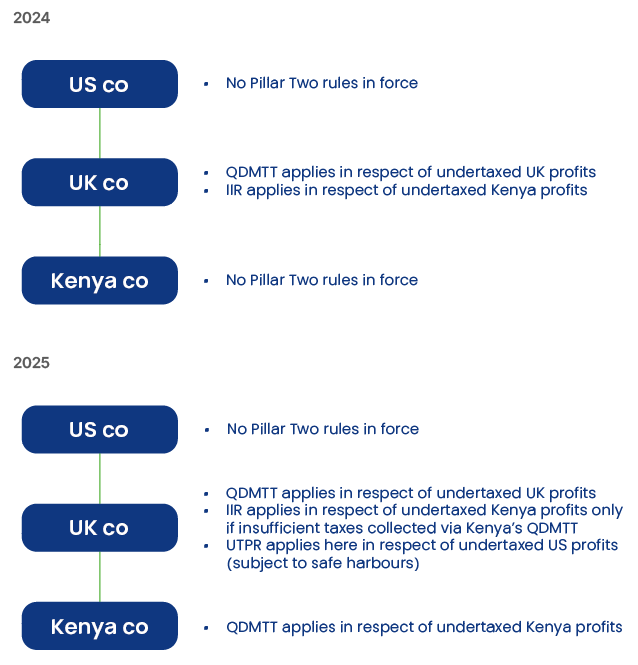For many in-scope groups, the first financial year affected by Pillar Two will be audited in 2025. So how should they prepare from a tax compliance and financial reporting perspective?
UK Pillar Two rules came into effect for periods beginning on or after 31 December 2023. Here’s a reminder of how they impact companies.
Pillar Two recap
Multinational enterprises (MNEs) within the scope of Pillar Two rules must calculate their effective tax rate (ETR) for each jurisdiction in which they operate. They are liable to pay a top-up tax for the difference between their ETR for each jurisdiction and the 15% minimum rate of tax. If the ETR domestically is 15% or more, no top-up tax is payable.
A qualifying MNE is broadly one with annual revenues above €750m in at least two of the previous four accounting periods, per the consolidated financial statements of the ultimate parent entity.
The UK’s implementation of Pillar Two, in line with the OECD model rules, comprises three elements in this order of precedence:
- A qualified domestic minimum top-up tax (QDMTT). This imposes a top-up tax domestically on any undertaxed UK activities of in-scope companies or groups (ie where the ETR is less than 15%). Unlike other elements of Pillar Two, the QDMTT can apply to wholly domestic groups (ie UK-only groups) as well as MNEs.
- An income inclusion rule (IIR). This charges a top-up tax to the ultimate parent company on the low-taxed income of a constituent entity. Where the ETR for an entity’s jurisdiction is below the minimum 15% rate, the ultimate parent is primarily liable for this tax to bring it up to 15%. If the ultimate parent’s jurisdiction has not implemented the Pillar Two rules, an intermediate parent entity is liable instead.
- An undertaxed profits rule (UTPR). This requires subsidiaries to collect top-up taxes if a parent entity is in a jurisdiction that has not implemented the QDMTT.
The UK introduced the IIR and QDMTT for periods beginning on or after 31 December 2023. The UTPR applies a year later, ie for periods beginning on or after 31 December 2024.
Tax compliance to consider in 2025
Groups in scope of Pillar Two for FY24 will need to register with HMRC for Pillar Two reporting, even if they do not think they’ll need to pay any top-up taxes. The deadline for registering is six months following the end of the first in-scope period. For example, a group that is in scope for the year ending 31 December 2024 will need to register by 30 June 2025.
They must also plan ahead for the submission of their first Pillar Two return for the following year. These are due by 30 June 2026, for groups that are first in scope for a period ending on or before 31 December 2024. Future periods’ Pillar Two returns will be due earlier (15 months after the end of the period).
Pillar Two has been implemented worldwide to different extents. Some jurisdictions, for example Canada, are in the same position as the UK – they have implemented all three elements of the Pillar Two rules (the UTPR has commonly been brought into effect a year after the other two rules). Others have adopted Pillar Two legislation but are at different stages of implementation. Kenya, for instance, has so far only introduced a QDMTT, with effect from 2025.
In contrast, some jurisdictions (such as China and the US) have remained quiet on Pillar Two implementation or have expressed opposition to the rules.
This inconsistency can make Pillar Two reporting more challenging:
- If the ultimate parent of a group has not implemented Pillar Two, the reporting and payment obligations may fall to intermediate parent entities.
- Subsidiaries may be required to pay top-up taxes for a parent company under the UTPR if the parent company’s jurisdiction has not implemented Pillar Two.
The application of top-up taxes may differ year on year, as more jurisdictions start to implement Pillar Two. For example, top-up taxes for a subsidiary might need to be paid by a parent company under its IIR in year one, but for year two they might need to be paid by the subsidiary itself through a local QDMTT.
Worldwide groups should therefore keep a close eye on the Pillar Two implementation status across all the jurisdictions in which they operate. This is to determine the exact reporting and payment requirements on a year-by-year basis.
Illustrative example
UK company with a US parent and Kenyan subsidiary, all entities with a 31 December year-end

Financial reporting considerations in 2025
When the UK rules were substantively enacted but not yet in force, groups were required to include narrative disclosures in their financial statements that set out the expected impact of Pillar Two on their group’s tax position.
For periods where the rules are in force, groups now need to include an actual tax provision for estimated Pillar Two taxes in their financial statements. But beware: rather than just checking disclosure of the expected amount of tax payable, auditors will be interrogating the amount provided for in more detail.
What kind of support are auditors likely to want to see?
- Supporting workings (with detailed explanations) for any provision recognised in the financial statements (or to evidence that no provision is required).
- Where any transitional safe harbour tests have been applied, an explanation of how the required conditions have been met.
- Descriptions of the data sources used to compile the workings.
The requirement to make an actual provision for Pillar Two taxes could, in theory, simplify the requirement for narrative disclosures in the financial statements. But groups in jurisdictions that are at different stages of Pillar Two implementation could have the worst of both worlds when it comes to disclosure requirements:
- Actual tax provisions for jurisdictions where the rules are in force
- Narrative disclosure for jurisdictions where the rules are substantively enacted but not yet in force.
As above, year by year the exact requirements could change depending on how Pillar Two implementation progresses across the world. This would only add further complexity for groups preparing their annual financial statements.
What is our advice?
Pillar Two is an evolving regime. Affected groups should therefore be in contact at regular intervals with their tax advisors to find out what their compliance and disclosure requirements are, and to prepare their related supporting papers. As FY24 is the first year when Pillar Two disclosure becomes relevant, auditors are likely to put this area under the microscope.
If you would like any support on Pillar Two matters please contact Mimi Chan or Jannat Moyeen.

